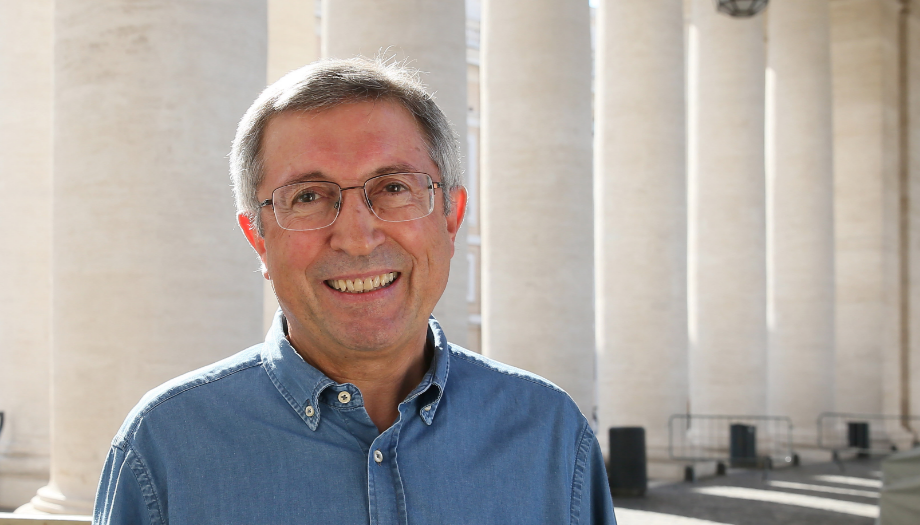Juan Vicente Boo is a veteran Vaticanist. He was ABC's correspondent in Brussels, New York and Rome for almost forty years. Since his arrival in Rome in 1998, he has been a daily witness of the last seven years of John Paul II, the pontificate of Benedict XVI and the first nine years of Pope Francis. As a journalist, he has accompanied these three popes aboard their aircraft on more than 60 international trips. He has been special envoy in 77 countries.
Boo has been promoter and CEO of the international television agency Rome Reports, specializing in the Vatican. On religious issues he has written The Pope of joy (2016), 33 keys to Pope Francis (2019) y Deciphering the Vatican (2021).
What should a reader keep in mind when assessing the information generated during the vacant seat period?
I suggest following veteran Vaticanists, because the journalists who come as special envoys -typically more than three thousand- do not have, logically, the capacity to analyze or to separate the essential from the secondary. As a former correspondent in Brussels or New York, I can assure you that reporting on the European Union, NATO or the United Nations is much easier than reporting on the Vatican, the most complex institution in the world because of its history and the variety of facets, from the spiritual to the artistic.
Moreover, one must be careful not to confuse a "white smoke" with a "gray smoke". In 2005 the cardinal dean took a special phone with him to inform the Vatican spokesman as soon as the elected cardinal had accepted. But he forgot, simply because... he was elected. It is important not to be fooled by official congratulations to a supposedly newly elected cardinal - as happened in 2013 - before the real name is announced on the balcony of St. Peter's Basilica.
Among those covering the conclave as journalists, do you think they know the Church or do many of the interpretive problems arise from a superficial approach?
Many of those who arrive as special envoys know the Church but, even among them, few know the Vatican. The problem of superficiality has two fronts: the inexperienced journalist who reports from Rome and the editors who know the terrain even less, select flashy but secondary topics, and are oriented in favor of "clicks" or sensationalist headlines. I have seen many journalists have a hard time seeing their bosses spoil their work.
What are the biggest challenges for a journalist reporting on a conclave?
For Vaticanists, the first challenge is to set aside personal preferences about candidates. It is often necessary to present selections of five or ten "papables" and then it is necessary to take into account the chances that the cardinals will vote for them.
The second challenge is to separate the wheat from the chaff. In the past, too much attention was paid to Italian Vaticanists. There has always been too much media "noise" in those days, but the current omnipresence of digital media, bloggers and influencers has made it deafening. Much of what is presented as "news"-especially snapshots-is worthless, even if the algorithms of the networks make it into trending topic or "viral".
You have already covered several of them, what ideas or situations are repeated and what novelties have you experienced from one to another?
I had the good fortune to cover the conclave of 2005, to elect the successor of John Paul II, and that of 2013, to elect the successor of Benedict XVI. They were very different. In 2005, very few cardinals had experience of a conclave since 26 years had passed since the previous one. Moreover, St. John Paul II was such an important figure that almost no one dared to intervene in depth in the meetings of cardinals prior to the conclave, or to propose candidates to step into the shoes of a giant.
Instead, the humble resignation of Benedict XVI and his serene way of studying each topic facilitated a very interesting debate in 2013 on the problems and priorities of the Church. This exercise always produces a "robot portrait" of the necessary candidate, and Jorge Bergoglio was chosen.
What strategies do journalists use to obtain reliable information in such an airtight event?
Veteran and discreet Vaticanists gain, over the years, the trust and friendship of the most valuable cardinals, and can exchange brief impressions with them during the pre-conclave days. But both veterans and newcomers can listen each day to the Pope's spokesman, who summarizes the content of the debates but without identifying the author of each intervention. Joaquin Navarro-Valls in 2005 and Federico Lombardi in 2013 did exceptionally well.
Have you seen attempts to manipulate public opinion before or during a conclave through the media?
Attempts - sometimes brutal - to manipulate public opinion have been constant throughout Francis' pontificate, and have increased in recent years. Most have come from U.S. economic and political interests. In the days leading up to the conclave, fake news about "papals" sometimes outnumber the real ones.
What has been the most surprising leak you have seen about a conclave?
In the conclaves of 2005 and 2013 there were no real leaks of what was happening in the Sistine Chapel, all were false speculations. They were all false. Perhaps the most amusing "leak" was made by St. John XXIII when he revealed several close votes with the Armenian Cardinal Agagianian: "In the conclave, our two names went up and down in the voting like chickpeas in boiling water".
The best and most well-documented book that has collected subsequent comments from the participating cardinals is "The Election of Pope FrancisAn Inside Account of the Conclave That Changed History."by Vaticanist Gerard O'Connell, published in 2020.









